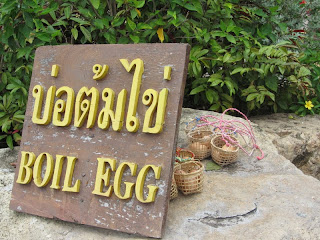 |
| My view from my room at the Wanasom Wellness and Aesthetic Resort |
 |
| Wellness Resort lobby |
 |
| The wellness resort |
 |
| Mae Fah Luang University |
A winding trip through tropically foliaged hills and along the Mekong River took us to Chiang Rai, where we checked into the Wanasom Wellness & Aesthetic Resort. The “wellness resort” is actually owned by Mae Fah Luang University, which has a thriving major in Travel & Tourism, so students from the college run the resort as part of their internship. It is a lovely, peaceful lodge at the top of a mountain, overlooking a lake and beautifully landscaped. They offer massage and beauty treatments there but we were too busy to take advantages of those services. We attended a lecture at the university entitled “The Past, Present, and Future of the Great Mekong Sub-Region” and then were special guests of the president of the university’s home for a dinner reception. At the dinner I sat with the charming wife of a Malaysian diplomat on the president’s verandah overlooking a lake. The college is amazing. Only 12 years old, it’s in a strikingly lovely natural setting and is thriving.
 |
| Dinner at the president's home at Mae Fah Luang University |
Mae Fah Luang University is also located near the “Golden Triangle” – the area where the Mekong River runs along the borders of Thailand, Laos, and Myanmar/Burma. Right on the Laotian border is the “Hall of Opium” – a state-of-the-art museum which traces the history of opium from its earliest use to the present. It really was a comprehensive look at the drug trade, and if there is ANYTHING you want to know about opium, ask me and I can probably tell you after spending a few hours in this museum! I was surprised to learn that (contrary to my previously held belief) opium did not originate in the Far East, but actually in India and was brought to China and Thailand by British tea traders. The exhibits documented the trade routes established during the days of imperialism, the Opium Wars, the paraphernalia used in opium dens, the harmful effects of addiction, and the international community’s response to the problem. I was struck by a Buddhist proverb written on one of the exhibits about drug addiction and rehabilitation:
“He who conquers many thousands of men in battle is not the noblest victor; But he who conquers himself is, indeed, the noblest victor.”
 |
| I am in Thailand's Golden Triangle looking across the Mekong River at Laos |
 |
| The old city wall at Chiang Rai |
I didn’t know what to expect when brought to a place called “The Hall of Opium” but it was really fascinating.
After lunch we visited the Chiang San school. We were almost an hour late and felt really badly when we saw the welcome they had waiting for us! About a hundred boys and girls lined both sides of the sidewalk waving Thai and American flags. Middle school students shyly approached us offering us flower garlands to wear as honored guests. At the end of the line was the school’s marching band and imagine our surprise when the conductor waved his baton and the teenaged Thai students broke into a rousing rendition of the Star Spangled Banner! How wonderful it was for them to learn this song just for our visit! It’s betting to be a bit embarrassing to be given this VIP treatment – if only these people knew how insignificant we really are!


























